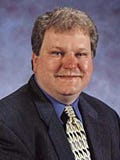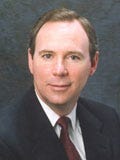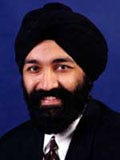Light Reading picks the biggest names and brightest stars in the telecom world
May 11, 2006

Question: What's more likely – that Light Reading editors will get off their duffs and update the Top Ten Movers & Shakers, or that Ralph Nader will be elected President of the United States?
Ha! Sorry Ralph – we beat you to it.
Since only our most geriatric readers will remember the last such list we published, let's recap: We nominate the people we think are having the biggest influence to change the way the telecom industry is working, primarly by implementing technological change. Note: We only nominate people are who classy – or those who even deign to answer our phone calls – so if your PR handler has at one time told us to stick our heads in an Iranian centrifuge, well then, sorry Charlie.
What about public input, you ask? We did issue a call for nominations, which, with a few exceptions, elicited the most shameless collection of PR pitches in the history of trade journalism. (See Movers & Shakers: Help Pick 'Em.)
For example, let's just excerpt what spokesman David Callisch of Ruckus Wireless had to say about Selina Lo, Ruckus CEO:
"Selina Lo Moves and Shakes. Waaaay more than some of the folks on your list.
"She’s taken a fundamentally unreliable technology - Wi-Fi – and made it carrier class. Once again, she’s at the right place, at the right time, with the right product..."
"She’s signed up PCCW (Hong Kong), Pioneer (US), Maxisat (Finland), Magnet (Ireland) and a whole bunch of rural US providers in less that a year. She’s also licensed her stuff to NETGEAR and has attracted the attention of the big boys (Sprint, Bell South, SBC, Motorola, etc.)...
" ... Plus she’s hot. What more could you ask for? Brains, beauty and brawn."
Thanks for sharing, David. As a marketing guy, don't you think that's just a little bit too much information? Plus, didn't Selina Lo win a Leading Light award? Sheesh, how greedy can you get? Better luck next year.
Now that you've got a glimpse inside the ugly mailbox of a Light Reading editor, take a look at the actual list. Let us know how you feel at [email protected] – we know you won't hold back.
Here's the list:
Table 1: Light Reading's Top Ten Movers & Shakers
Contents:
Page 2: Matt Bross, CTO, BT
Page 3: Kevin Martin, Chairman, FCC
Page 4: Mark Wegleitner, CTO, Verizon
Page 5: Chris Rice, Executive VP, AT&T
Page 6: Mike Volpi, Senior VP, Cisco
Page 8: Carl Russo, CEO, Calix
Page 9: Jagdeep Singh, CEO, Infinera
Page 10: Ron Sege, CEO, Tropos
Page 11: Blake Krikorian, CEO, Sling Media
Next Page: Matt Bross, CTO, BT
— The Staff, Light Reading
Matt Bross, CTO at BT Group plc (NYSE: BT; London: BTA), is undoubtedly one of the global telecom industry's most influential individuals for several reasons. First, his sartorial reputation. Following his choice of neckwear at a recent International Engineering Consortium (IEC) event in London, Bross is now recognized as one of the industry's most stylish dressers. (See 21C World Forum: It's a Tie!)
First, his sartorial reputation. Following his choice of neckwear at a recent International Engineering Consortium (IEC) event in London, Bross is now recognized as one of the industry's most stylish dressers. (See 21C World Forum: It's a Tie!)
But he isn't just a natty dresser. As the chief technologist behind BT's next-generation network, the 21CN, he is making judgments and decisions about telecom network infrastructure that the rest of the world is watching. His decisions usually make or break business trends for multibillion-dollar capitialization companies, and he also helps set the direction for technology in the industry at large. (See BT Closes 21CN Deals, Touts IPTV, Vendors Sign BT 21CN Contracts, BT Issues 21CN Ethernet RFP, and BT's Bross: Ethernet Will Deliver.)
In fact, one could argue that BT has moved more aggressively than any other global incumbent service provider into the integrated IP network. The 21CN program – decommissioning about 15 different networks and shifting all services onto a single IP and Ethernet-based infrastructure by 2010 – is the at center of the telecom industry's attention: Other carriers want to learn from BT's migration plans and project execution; and vendors want to see how they can land a place in the industry's biggest next-generation network shop window.
And then there's the 21CN budget – a whopping £10 billion ($18.6 billion), of which about £3.4 billion ($6.3 billion) is being funneled towards the carrier's eight "preferred suppliers," while a further monster, but unknown, amount is set to be spent on next-generation Ethernet technology. As they say, follow the money. (See BT Issues 21CN Ethernet RFP.)
Being named as one of those elite eight by Bross and Co. will certainly have helped Huawei Technologies Co. Ltd. 's credibility and international sales top line, while the impact on smaller, more specialist firms, such as SIP application server firm Ubiquity Software Corp. (London: UBQ), is set to be immense. (See Ubiquity Leads New Round of 21CN Deals and Huawei Picked for BT's 21CN.)
Oh, and we hear Bross can boogie, too, but that's another Top Ten...
Next Page: Kevin Martin, Chairman, FCC
In April, the President of the United States again nominated Kevin Martin as Chairman of the U.S. Federal Communications Commission (FCC) , a move that surprised no one given Martin's steady climb to power since he first joined the Commission in 2001. And yea, the telcos did rejoice! Martin, perceived as friendlier to the incumbents, is now a central figure in the telco assault on the residential video market, as well as a subtle, piecemeal rewriting of the Telecommunications Act of 1996, the legislative activity that helped ignite the entire telecom bubble in North America (and which may have also set up the crash). But the times, they are a changing. IPTV and broadband are moving full-steam ahead, and the FCC is now digging into the nation's antiquated video franchising rules, calling for à la carte programming from cable companies, and going with a light touch on the subject of net neutrality. All in all, these are big changes for the marketplace. Martin and his Commission, which are probably more aligned with the commissioner than they were under former Chairman Michael Powell, are extending open arms to any competitors willing to take on entrenched cable companies in the video and residential broadband markets. (See Whitacre, Martin Line Up on Neutrality, FCC Brings Video Debate to Texas, and Martin Phones In on Franchising.)
Martin, perceived as friendlier to the incumbents, is now a central figure in the telco assault on the residential video market, as well as a subtle, piecemeal rewriting of the Telecommunications Act of 1996, the legislative activity that helped ignite the entire telecom bubble in North America (and which may have also set up the crash). But the times, they are a changing. IPTV and broadband are moving full-steam ahead, and the FCC is now digging into the nation's antiquated video franchising rules, calling for à la carte programming from cable companies, and going with a light touch on the subject of net neutrality. All in all, these are big changes for the marketplace. Martin and his Commission, which are probably more aligned with the commissioner than they were under former Chairman Michael Powell, are extending open arms to any competitors willing to take on entrenched cable companies in the video and residential broadband markets. (See Whitacre, Martin Line Up on Neutrality, FCC Brings Video Debate to Texas, and Martin Phones In on Franchising.)
None of the above issues are permanently settled, and there's much more debate to be had as lawmakers endeavor to strike the perfect balance of making the communications world seem friendly for competition without giving the appearance of just handing over all the power to the nation's two largest phone companies, AT&T Inc. (NYSE: T) and Verizon Communications Inc. (NYSE: VZ). Martin’s position on many of these issues, in fact, has yet to be wholly formed. But one thing is true: A single act by the FCC can have the affect of instantaneously changing billions of dollars in market capitalization, and directing billions of dollars of investment into new areas.
As these debates stay on the boil throughout this year and next, the most sought-after sound bites will be sung by the Chairman himself. And, love him or loathe him, Martin is more of a presence – more a Mover and Shaker – than the son-of-a-bigwig who previously occupied the office. (See FCC's Martin: Markets Rule.)
Next Page: Mark Wegleitner, CTO, Verizon
Let’s just put it this way: How can you not be a mover and shaker when you control a large portion of a $15 billion capital spending budget?  For a longtime Bell Head, Wegleitner is a pretty progressive dude – in fact, he’s a bandwidth hog. In the Verizon Communications Inc. (NYSE: VZ) tech chief’s vision, the customer ought to have a 100-Mbit/s pipe, preferably via fiber. Wegleitner is responsible for much of Verizon’s aggressive entrance into the FTTH market, which the company has been deploying as part of its FiOS project at a speed that has surprised many. (See Verizon: Wireless Funds Fiber, FCC Brings Video Debate to Texas, Fiber Spreads in the USA, and RBOC IPTV: The Quiet Ones.)
For a longtime Bell Head, Wegleitner is a pretty progressive dude – in fact, he’s a bandwidth hog. In the Verizon Communications Inc. (NYSE: VZ) tech chief’s vision, the customer ought to have a 100-Mbit/s pipe, preferably via fiber. Wegleitner is responsible for much of Verizon’s aggressive entrance into the FTTH market, which the company has been deploying as part of its FiOS project at a speed that has surprised many. (See Verizon: Wireless Funds Fiber, FCC Brings Video Debate to Texas, Fiber Spreads in the USA, and RBOC IPTV: The Quiet Ones.)
Verizon also has an interesting approach to video. Rather than go straight to IP video, the company has implemented a hybrid approach. When it deploys a new fiber connection to a home, it splits the fiber into two wavelengths. On one wavelength, it broadcasts video using the cable model, using quadrature amplitude modulation (QAM) over a radio frequency (RF) network. Using the other wavelength, it delivers Internet access and video on demand (VOD) over IP. Eventually Verizon plans to move to all IP, but, for the moment, it’s adamant that IPTV technology is not mature enough to rival the quality of an RF broadcast.
Although this plan was criticized at first, it has turned out to be the correct way to go, as reported delays in Microsoft’s IPTV system are causing some pain for providers that have gone with straight IPTV. And Verizon remains the only North American RBOC delivering video directly to the home over an all-fiber connection (See Verizon's Elby: IPTV Could Take Years and RBOCs Want Inside Your House.)
Wegleitner also has a vision for what to do with the fiber connection to the house, beyond just offering voice and video: The company would like to "extend management to other devices... so that we can really have a picture of what’s going on in the household help the consumer configure and manage what they’ve got,” he says. It would do this via a broadband gateway and the management standard TR-069. (See RBOCs Want Inside Your House.)All in all, Wegleitner’s technology direction has given Verizon several options in the pursuit of next-generation services. It’s also got big stakes for vendors such as Alcatel (NYSE: ALA; Paris: CGEP:PA), Cisco Systems Inc. (Nasdaq: CSCO), Microsoft Corp. (Nasdaq: MSFT), Motorola Inc. (NYSE: MOT), Tellabs Inc. (Nasdaq: TLAB; Frankfurt: BTLA), and Westell Technologies Inc. (Nasdaq: WSTL), which are pursing some of the large product RFPs associated with the FTTH rollout. (See RBOCs Aim for 10M GPON Subs and Sources: Cisco Eyeing Scientific-Atlanta.)
Next Page: Chris Rice, Executive VP, AT&T
If cable overlay vs. IPTV is the telco industry's Coke/Pepsi debate, Chris Rice may have made the choice of a new generation. In the last 12 months, Rice, AT&T Inc. (NYSE: T)'s executive VP of network planning and engineering, has become the designated chief defender of the company's decision to roll out a pure IP-based TV service as part of its next-generation access network makeover, Project Lightspeed.
In the last 12 months, Rice, AT&T Inc. (NYSE: T)'s executive VP of network planning and engineering, has become the designated chief defender of the company's decision to roll out a pure IP-based TV service as part of its next-generation access network makeover, Project Lightspeed.
The sheer size of AT&T's reach and the visibility it has created for Lightspeed put Rice in an influential position. And we note his star has been on the rise since the company formerly known as SBC Communications Inc. (NYSE: SBC) went on its buying spree. (See Source: Eslambolchi Out at 'New' AT&T.)
With all the pressure on AT&T to deliver skeptic-crushing numbers and knock-your-socks-off technology, Rice's technology cheers and jeers in the next few months could be the stuff of telco industry legend. He's not easy for vendors to please, and if he gives a thumbs-down to any service or vendor while Lightspeed is lighting up, millions of dollars worth of market cap and tech investment could be on the move.
We like that Rice is up for a good chat, too. Without mincing words, he frequently and fluently takes on issues such as how much bandwidth is enough for consumer homes, how big a problem P2P is traffic in telco networks, what's wrong with telco gear vendors, and why home networking is the wave of the future in residential service delivery. (See RBOCs Want Inside Your House, RBOCs Wait & See on P2P, and RBOCs to Vendors: More Nines, Please.)
Adding to Rice's rhetoric is AT&T's addition of satellite broadband, Internet-based VOD, and a fairly future-proof residential gateway to the company's access network bundle. (See AT&T to Offer Satellite Broadband, AT&T, TotalVid.com in VOD Deal, and AT&T Adds Akimbo VOD.) With more options for more people, this could tilt the table in Rice's favor and make the company's IPTV plans, no matter how humble at first, seem larger than life.
Next Page: Mike Volpi, Senior VP, Cisco
Yes: Another list, another Volpi nomination. (See LR Unveils Public Co. Statesman Finalists and LR Public Statesman Finalists Unmasked.) We can't help it. Volpi tends to be the big-picture guy at Cisco Systems Inc. (Nasdaq: CSCO), whether it's in the company's acquisition strategy or at the helm of projects such as the CRS-1 core router.  This time, it's the Scientific-Atlanta Inc. acquisition, that $7 billion deal completed in February, that catches our eye. (See Cisco to Acquire Scientific-Atlanta.)
This time, it's the Scientific-Atlanta Inc. acquisition, that $7 billion deal completed in February, that catches our eye. (See Cisco to Acquire Scientific-Atlanta.)
Scientific-Atlanta is crucial to Cisco’s future. It is expected to ring up $500 million in Cisco's July quarter, compared to nearly $8 billion for the company overall. But more importantly, Cisco is banking on Scientific-Atlanta to carry the company into the Internet's next wave, one that will be dominated by home-broadband access.
The broadband gateway will sit at the nexus of all kinds of new services, including video, voice, and broadband Internet, as well as whatever else comes down the pike. By acquiring Scientific-Atlanta, Cisco was perceived by many to change the game. Cisco admitted the deal was partly prompted by the recent strength Alcatel (NYSE: ALA; Paris: CGEP:PA) showed in IPTV buildouts. (See Sci-Atlanta: Cisco's IPTV Lifeline?) Pursuing a next-generation device that can integrate wireless functions, broadband access, home networking, and video capabilities will be crucial to Cisco’s positioning for service providers.
Now, Volpi’s got to make it all work. If his plans work out, Cisco will arguably have the linchpin in the emerging consumer networking market.
Next Page: Basil Alwan, President of IP, Alcatel
In many ways, Basil Alwan, president of Alcatel (NYSE: ALA; Paris: CGEP:PA)'s IP division, is the ultimate Mover and Shaker, because he moved to Alcatel and shook it out of its IP torpor. And while many outsiders credit CEO Serge Tchuruk and COO Mike Quigley for helping Alcatel survive and grow in the past four years, ask Alcatel insiders and industry veterans who Alcatel's unsung hero is – and they'll tell you it's Alwan.
And while many outsiders credit CEO Serge Tchuruk and COO Mike Quigley for helping Alcatel survive and grow in the past four years, ask Alcatel insiders and industry veterans who Alcatel's unsung hero is – and they'll tell you it's Alwan.
The reason? Two years ago, the all-important telecom IP equipment market was basically a battle between Cisco Systems Inc. (Nasdaq: CSCO) and Juniper Networks Inc. (NYSE: JNPR). Then, in May 2003, Alcatel acquired Alwan's firm, TiMetra, for $150 million in stock, a price that some scoffed at. (See Alcatel & TiMetra Seal the Deal.)
Now it looks like a bargain, as Alwan hung in at Alcatel as president of IP activities and developed carrier-class products, spearheaded by the 7750 router, which has attracted the attention and capital investment of major carriers such as AT&T Inc. (NYSE: T), BT Group plc (NYSE: BT; London: BTA), China Telecom Corp. Ltd. (NYSE: CHA), Deutsche Telekom AG (NYSE: DT), and Telstra Corp. Ltd. (ASX: TLS; NZK: TLS) (See China Telecom Deploys 7750, Alcatel Elaborates on 21CN Win, Telstra Unveils Switch to IP, DT Deploys Alcatel, and Alcatel Wins $1.7B SBC Deal.)
Those carrier accounts helped Alcatel's IP product business to grow from about 15 customers and revenues of $37 million in 2004 to more than 110 carrier customers and revenues of $250 million in 2005. That, according to market researchers, turned the vendor's IP router division into the sector's number two player, bumping Juniper into third spot. (See Alcatel Router Revenues Surge and Alcatel Touts IP Edge Share.)
With Alcatel about to go through a massive upheaval as it merges with Lucent Technologies Inc. (NYSE: LU), some industry pundits are already wondering whether Alwan will stick with the equipment giant or strike out on his own and start something new. If he does decide it's time to do something new, it's unlikely Alwan would have any problem attracting VC investment and carriers' attention.
Next Page: Carl Russo, CEO, Calix
Captain Carl is back. Well, OK, he never really went anywhere. But we’ve put him back on the list. We booted Russo, the CEO of broadband access equipment maker Calix, back in 2003, probably just cause we were bored. After all, that was in the teeth of the telecom recession, when Calix still didn’t do Ethernet, its direction was somewhat murky, and it was printing up more paper than the federal government. (See Calix in Billion Share Bind? and Calix Couches Ethernet Story.)
We booted Russo, the CEO of broadband access equipment maker Calix, back in 2003, probably just cause we were bored. After all, that was in the teeth of the telecom recession, when Calix still didn’t do Ethernet, its direction was somewhat murky, and it was printing up more paper than the federal government. (See Calix in Billion Share Bind? and Calix Couches Ethernet Story.)
As things have turned out, we probably should have trusted Carl. The massive share recapitalization which brought Russo on board as Calix’s CEO – and is believed to have given him a substantial stake – may have rescued the company. Speed Racer Russo got the company back on track, streamlined the staffing, and put the focus on one thing: adding more products and selling them. (See Russo Returns, Leading Lights Finalists, and Calix Networks.)
Most importantly, the products and their features have matured. Calix has moved beyond cupholders, and has added Ethernet functions and B-RAS functionality, and even plans PON for its products. And, most importantly, it won Sprint Corp. (NYSE: S). (See Nortel, Calix Get Access at Sprint). By most estimates, Calix is in the triple-digit millions in revenue and could be well positioned for an IPO. (See Calix Goes to the Node, Calix to Buy OSI, Calix Ships a Million , and LR Picks Leading Lights IPO/M&A Finalists)
Best of all, despite the bundles of Benjamins that Russo took in the Cerent haul, he seems to be the same old dude, as driven as ever. So is he the Mark Cuban of telecom or the Howard Hughes of networking? (See IPOs Happen: Carl Russo Speaks.) Russo may be able to afford his jet and a basketball team if Calix can clear the ever-rising hurdle of the telecom technology IPO.
Next Page: Jagdeep Singh, CEO, Infinera
It's been a while since a company polarized telecom equipment community opinion as much as Infinera Corp. (Nasdaq: INFN), and that's down to CEO and industry veteran, Jagdeep Singh.  Having seen his previous equipment startup, Lightera Networks, sold to Ciena Corp. (NYSE: CIEN), Singh founded the optical networking vendor back in 2000, when it was known as Zepton Networks. (See Zepton: Take Me to Your Leaders.)
Having seen his previous equipment startup, Lightera Networks, sold to Ciena Corp. (NYSE: CIEN), Singh founded the optical networking vendor back in 2000, when it was known as Zepton Networks. (See Zepton: Take Me to Your Leaders.)
With a pile of cash, Singh and his team concentrated on making the optical-electrical-optical (OEO) conversion of wavelengths a cheap and affordable alternative to the all-optical solution regarded as the industry norm. (See Infinera's Amp-less Ambition.)Once renamed, Infinera eventually unveiled the technology behind the vision in May 2004, and, with more than $200 million in funding behind it, began shipping its DTN product in November 2004.
Since then, the company has been riding the new optical wave, having announced a number of carrier customers, raced up the optical port shipping charts, made an acquisition, and been linked with Google (Nasdaq: GOOG)'s network plans. (See Optical Networking: All Grown Up, Infinera Reaches Level 3, Infinera Goes Live, Infinera Wins Flag Deal, XO Selects Infinera, Infinera Claims 10G Lead, Infinera Bags Big Bear, and Infinera Courts Rumors .)
That progress shook up the optical market and generated multiple message exchanges on Light Reading's message boards.
But when Singh accidentally-on-purpose told Light Reading in late March that Infinera was closing enough business to warrant an annual revenue run rate of $100 million, it caused minor hysteria. (See the message boards at the foot of Infinera Numerates Its Numbers.)
Singh's Mover and Shaker credentials were sealed when, later that same day, BT Group plc (NYSE: BT; London: BTA) CTO Matt Bross name-checked Singh during a media briefing, noted that he was monitoring Infinera's technology developments, and said he might even source gear from Infinera for BT's high-profile 21CN next-generation network project.
Next Page: Ron Sege, CEO, Tropos
Tropos Networks Inc. CEO Ron Sege didn't invent wireless mesh networks. But he has done a really good job of making a business case for them, using a "safety first" approach that has paved the way for the municipal WiFi craze sweeping the nation. (See Metro WiFi to Soar.) "We have plotted our strategy from selling to munis for public safety to selling to munis for consumer applications," says Sege, who took the helm at Tropos in January 2004 after a stint running Ellacoya Networks Inc. Trivia: The previous Tropos CEO was David Hanna, son of William Hanna of Hanna-Barbera cartoon fame.
"We have plotted our strategy from selling to munis for public safety to selling to munis for consumer applications," says Sege, who took the helm at Tropos in January 2004 after a stint running Ellacoya Networks Inc. Trivia: The previous Tropos CEO was David Hanna, son of William Hanna of Hanna-Barbera cartoon fame.
A friend describes Sege as a "fairly hairy-chested and very athletic” guy who spends much of his spare time on wheels. He drives a Porsche Boxter, a Harley, and a dirt bike. He’s also known for having a Bluetooth device glued to his ear. "He always has that thing on, incessantly," says one source, who adds that Sege "has a constant smile on his face, like he just remembered the punch line to a joke he told last night but forgot the punch line." (See Tropos Taps Time-Worn Talent.)
But Tropos’s success is no joke. Under Sege's sage sway, Tropos has managed to rack up some 330 deployments in 30 countries. The company's MetroMesh systems are installed or due to be installed in cities such as Philadelphia, Los Angeles, and Kuala Lumpur.
Much of the Tropos success is due to a smart partnering strategy, which has helped it to compete against fellow mesh players such as Nortel Networks Ltd. , Cisco Systems Inc. (Nasdaq: CSCO), Strix Systems Inc. , and BelAir Networks Inc. (See Tropos Gets With the Program.)
Tropos has more than 60 reseller and system integrator partners, including HP Inc. (NYSE: HPQ), Affiliated Computer Services Inc. (ACS) (NYSE: ACS), and IBM Corp. (NYSE: IBM). The company also has key alliances with EarthLink Inc. (Nasdaq: ELNK) and Motorola Computer Group (which has a line of mesh products of its own but still chooses to team with Tropos on muni deployments). Tropos also provides mesh hardware for Google (Nasdaq: GOOG), which recently teamed up with Earthlink to win bids for municipal WiFi networks in San Francisco and Mountain View, Calif. Sege says he knows of some 190 municipal WiFi networks in some stage of planning right now. (See Tropos Turns Up the Radios.)
Next stop, telecom: "We are actually now selling to carriers who are starting to bid on these projects," Sege says.
Next Page: Blake Krikorian, Sling Media CEO Sling Media Inc. CEO Blake Krikorian, now considered by many to be the father of “place shifted” video, is shaking up things aplenty for telecom and cable providers. His product, the SlingBox, grabs video from a cable box, satellite receiver, or DVR in the home and slings it out over a broadband connection to a laptop or PC anywhere in the world. (See LR Picks Best New Services.) Krikorian and his product have helped advance the idea that consumers really can have their video content anytime, anywhere, and on there own terms. Telcos (and anybody else) delivering communication and entertainment services will be forced to respond.
Krikorian and his product have helped advance the idea that consumers really can have their video content anytime, anywhere, and on there own terms. Telcos (and anybody else) delivering communication and entertainment services will be forced to respond.
Krikorian has been very aggressive and very successful at both promoting and defending the “place-shifting” concept. The guy is everywhere. He is a hot ticket on the tech convention circuit, and he even made his case in front of a Senate committee hearing in March. One executive who markets a similar place-shifting product at Sony Corp. (NYSE: SNE) credited Krikorian for “taking on all comers” in defense of “place shifting.” (See Sling Media: We're Good for Cable.)
Krikorian’s company is also important because it is single-handedly stretching the definition of “fair use” for video content. This has earned an enthusiastic response from gadget freaks and tech media. But it has attracted even more attention from video content owners and distributors that believe Sling’s place-shifting technology might violate their copyrights. At any gathering of more than five studio, broadcast, or cable execs, the Sling subject is almost certain to come up. As the telcos move into the video business with IPTV, they may be forced to deal with those “fair use” concerns as well. (See HBO Exec: Sling Slags Copyrights.)
Krikorian launched the SlingBox in 2004 and says the number of devices sold so far is “in the six figures.” Sling recently upped the ante by releasing a version of the product that slings video to cell phones and PDAs, in a move that anticipates the uptake of wireless video service in the U.S. Even if the company’s forward momentum is slowed by legal entanglements, Sling will have ushered in a new way of watching video that consumers may not want to live without. (See Aarohi Mum on Acquisition Talk.)
You May Also Like








